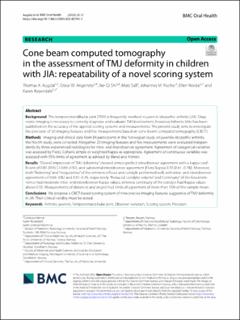| dc.contributor.author | Angenete, Oskar W | |
| dc.contributor.author | Augdal, Thomas Angell | |
| dc.contributor.author | Shi, Xie-Qi | |
| dc.contributor.author | Säll, Mats | |
| dc.contributor.author | Fischer, Johannes Maria | |
| dc.contributor.author | Nordal, Ellen Berit | |
| dc.contributor.author | Rosendahl, Karen | |
| dc.date.accessioned | 2023-01-31T15:57:58Z | |
| dc.date.available | 2023-01-31T15:57:58Z | |
| dc.date.created | 2023-01-29T11:32:11Z | |
| dc.date.issued | 2022 | |
| dc.identifier.issn | 1472-6831 | |
| dc.identifier.uri | https://hdl.handle.net/11250/3047511 | |
| dc.description.abstract | Background
The temporomandibular joint (TMJ) is frequently involved in juvenile idiopathic arthritis (JIA). Diagnostic imaging is necessary to correctly diagnose and evaluate TMJ involvement, however, hitherto little has been published on the accuracy of the applied scoring systems and measurements. The present study aims to investigate the precision of 20 imaging features and five measurements based on cone beam computed tomography (CBCT).
Methods
Imaging and clinical data from 84 participants in the Norwegian study on juvenile idiopathic arthritis, the NorJIA study, were collected. Altogether 20 imaging features and five measurements were evaluated independently by three experienced radiologists for intra- and interobserver agreement. Agreement of categorical variables was assessed by Fleiss’, Cohen’s simple or weighted Kappa as appropriate. Agreement of continuous variables was assessed with 95% limits of agreement as advised by Bland and Altman.
Results
“Overall impression of TMJ deformity” showed almost perfect intraobserver agreement with a kappa coefficient of 0.81 (95% CI 0.69–0.92), and substantial interobserver agreement (Fleiss’ kappa 0.70 (0.61–0.78)). Moreover, both “flattening” and “irregularities” of the eminence/fossa and condyle performed well, with intra- and interobserver agreements of 0.66–0.82 and 0.55–0.76, respectively. “Reduced condylar volume” and “continuity” of the fossa/eminence had moderate intra- and interobserver Kappa values, whereas continuity of the condyle had Kappa values above 0.55. Measurements of distances and angles had limits of agreement of more than 15% of the sample mean.
Conclusions
We propose a CBCT-based scoring system of nine precise imaging features suggestive of TMJ deformity in JIA. Their clinical validity must be tested. | en_US |
| dc.language.iso | eng | en_US |
| dc.publisher | BMC | en_US |
| dc.rights | Navngivelse 4.0 Internasjonal | * |
| dc.rights.uri | http://creativecommons.org/licenses/by/4.0/deed.no | * |
| dc.title | Cone beam computed tomography in the assessment of TMJ deformity in children with JIA: repeatability of a novel scoring system | en_US |
| dc.title.alternative | Cone beam computed tomography in the assessment of TMJ deformity in children with JIA: repeatability of a novel scoring system | en_US |
| dc.type | Peer reviewed | en_US |
| dc.type | Journal article | en_US |
| dc.description.version | publishedVersion | en_US |
| dc.source.volume | 23 | en_US |
| dc.source.journal | BMC Oral Health | en_US |
| dc.source.issue | 12 | en_US |
| dc.identifier.doi | https://doi.org/10.1186/s12903-022-02701-5 | |
| dc.identifier.cristin | 2117416 | |
| cristin.ispublished | true | |
| cristin.fulltext | original | |
| cristin.qualitycode | 2 | |

